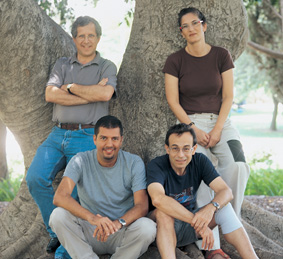The world runs on impurity. Impurities in the colorless mineral beryl turn it to emerald. A bit of carbon tossed into pure iron hardens it into steel. And the ubiquitous silicon chips that form the basis of everything from our computers and electronic devices to musical birthday cards must contain impurities to work. In a process called doping, small amounts of other materials are introduced into pure silicon, and these impurities are what enable electricity to flow through the semiconductor and allow designers to control the electronic properties of the material.
Scientists at the Weizmann Institute are working on substitutes for the silicon that most of the electronics industry relies on today. Molecular electronics is based on single organic (carbon-based) molecules or thin layers the thickness of a single molecule. Semiconductors based on organic molecules might be inexpensive, biodegradable, versatile and easy to manipulate, and the wide variety of these molecules might open up all sorts of possibilities for new applications. But, like today's silicon semiconductors, organic monolayers would need to be doped to work efficiently.
The question facing scientists working in the field is whether such molecular systems, which tend to be delicate and hard to manipulate, can be properly doped. That is, can these materials first be purified and then impurities added to order? Prof. David Cahen and postdoctoral fellow Dr. Oliver Seitz of the Weizmann Institute's Materials and Interfaces Department, together with Drs. Ayelet Vilan and Hagai Cohen of Chemical Research Support, all of the Faculty of Chemistry of the Weizmann Institute, and Prof. Antoine Kahn, from Princeton University (a regular visitor to the Institute), showed for the first time that such doping of molecular electronic systems is, indeed, possible.
First they succeeded in purifying the molecular layer to such an extent that the remaining impurities did not affect the system's electrical behavior. The scientists then doped the clean monolayers by irradiating the surface with UV light or weak electron beams. In this case, the impurities were not a second kind of molecule but a change in the chemical bonds between the carbon atoms that make up the molecular layer. These bonds ultimately influenced electronic transport through the molecules.
This achievement was recently described in the Journal of the American Chemical Society (JACS). The researchers foresee that this method may enable scientists and electronics engineers to substantially broaden the use of organic monolayers in the field of nano-electronics. Cahen: "After establishing an ideal system (a uniform layer of 'pure' molecules), we can dope it, introducing impurities that will allow us to control electron transport properties according to specific needs." Seitz: "If I am permitted to dream a little, it could be that this method will allow us to create types of electronics that are different, and maybe even more environmentally friendly, than the standard ones that are available today."
Prof. David Cahen's research is supported by the Nancy and Stephen Grand Research Center for Sensors and Security; the Philip M. Klutznick Fund for Research; Mr. Yehuda Bronicki, Israel; and Mr. and Mrs. Yossie Hollander, Israel. Prof. Cahen is the incumbent of the Rowland and Sylvia Schaefer Professorial Chair in Energy Research.

